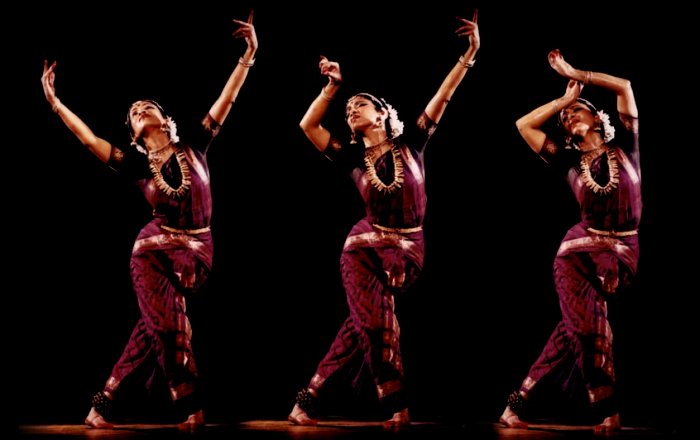
 |
(Excerpts from Interviews with Alarmel Valli)
| The Great Art of Bharatanatyam: Alarmel Valli speaks up in Interview by Andre Fonteyne Interviewed during her visit to Europe by Andre Fonteyne, arts correspondent of the Flemish newspaper De Morgen which commissioned the interview & reproduced in Sruti, India's premier music and dance magazine, Issue 209, February 2002. http://tamilnation.co /hundredtamils/alarmel.htm My Gurus and Tradition "My Gurus helped me realise that tradition, in the right hands, has infinite capacity for evolving and renewing itself all the time, but at its own pace - naturally, gracefully and inevitably. Today, while my style of dance has the form and vocabulary of Bharatanatyam, it is yet distinctly my own." Creativity "A dancer’s life is a continuous process of artistic evolution - of reflection, of dynamic growth and change. We choreograph new dances, we renew and rework old ones. Even during performances we are continuously improvising. When I first studied dance, I learnt the rules. Over the years, with constant practice, I was able to internalise them. At this stage, I found I was making some rules of my own. But the final step, is when you identify completely with the dance. To borrow the words of YB.Yeats- 'O Body swayed to music, O Brightening glance! How can we know the Dancer from the Dance?!' ". "When innovation is motivated by the ‘What’s new?’ syndrome, the result is often a presentation which may be politically correct, but artistically impoverished. I believe that true growth and creativity comes from within you. It has to do with being true to yourself and your art. All meaningful change springs from this integrity." Pressure to be ‘socially relevant’ in Bharatanatyam "I do not subscribe to the view that all dance has perforce to be an overt social comment. In fact, I tend to be rather skittish about being politically correct for the sake of being politically correct. I choose my themes because they move me, or touch a chord in me - themes that are universal. I believe that the urge to dance can find expression in many, diverse ways. Indian classical dance is a celebration of the body, mind and ultimately of the spirit. It can be a joyous, healing, uplifting experience, both for the dancer and the audience. I feel it is this ability to move and sometimes, even change a person’s life, that is the acid test of the timelessness and human relevance of Bharatanatyam." Choreography "When I was only 16, my Guru explained the processes underlying his choreography to me. It helped me perceive that Bharatanatyam has the inherent capacity to assimilate innovation. It is an expressive and evocative language that I use to write my personal dance-poetry. The songs and poems are but the outlines. When I choreograph, I am both painter and poet. I add the colours and tints to the outline to bring it to life. I embroider my own dance poem around the poem. I draw upon the rich and diverse store of poetry, literature and music that is available to us, and I also work with modern poets and musicians to create new compositions." "In Bharatanatyam, the form is but the foundation on which the creative dancer builds structures, both in time and space, drawing from her individual experience of music, movement and life. Every song or poem therefore, is re-created by the dancer, becoming her personal statement. Unlike a completed painting, the dance grows and changes and is re-interpreted with every presentation." The poetry of dance "In Bharatanatyam, where geometry is such an important factor and the most easily recognisable yardstick to evaluate, there is a risk of making grammar and technique, ‘the be all and end all’ of dance - of not seeing the wood for the trees. But with this blinkered approach, you can never savour the power, beauty and poetry of movement." Music and Dance "The key to my intuitive understanding of dance, is the close inter-relation between movement and music. While studying music with a singer as profound as Smt.T.Muktha, I discovered an entirely new dimension to my art. Suddenly, not only the words of the lyric, but every nuance, pause, or trill in the music found expression in corresponding movements of the head or body. When I dance, I sing - with my body." The sensual and the spiritual "While being deeply spiritual, Bhratanatyam is also vibrant, joyous and sensuous. If you completely divorce sensuality from dance and turn it into something rarefied and inaccessible, it loses its appeal, because it ceases to communicate. I find it exhilarating, that this highly evolved, grammatical, sophisticated dance form allows you to be playful and adventurous like a child, to feel the wonder of discovering everything afresh. Dance, for me is sheer joy, at different levels - from the sublimely spiritual to the vibrantly physical, from the purely intellectual to the intensely emotional. At its most intense level, it is a joyous prayer with my very being." |